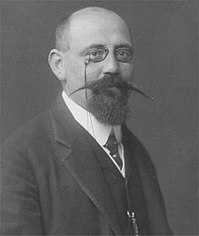Election to the National Council in Austria in 1945
The first National Council election in the Second Republic took place on November 25, 1945. The ÖVP under Leopold Figl emerged victorious from the election and achieved an absolute majority in the mandate. Second came the SPÖ under State Chancellor Karl Renner . The KPÖ fell well short of expectations and only barely made it into the National Council.
Overall, a little less than 3.5 million Austrians were eligible to vote. The turnout was 93.27 percent.
background
The National Council election in 1945 was the first democratic election after the military suppression of National Socialism and at the same time the fifth National Council election in the history of Austria . At the same time, it was the first democratic election since the authoritarian coup by Chancellor Engelbert Dollfuss in 1933, which went down in history as the " self-elimination of parliament " .
With the re-establishment of an independent Austrian state at the end of April 1945, the occupying powers first installed the social democrat Karl Renner as chancellor of a provisional state government made up of the SPÖ, ÖVP and KPÖ. The NSDAP was banned with the prohibition law immediately after the war and was therefore no longer allowed to take part in the elections. Around 800,000 former NSDAP members were not eligible to vote in the first National Council election in 1945. Many men who were actually entitled to vote had not yet returned from captivity. Women made up the majority of the electorate.
Nationwide, the occupying powers had only allowed ÖVP, SPÖ and KPÖ to vote, only in the British occupation zone in Carinthia was the Democratic Party of Austria (DPÖ) allowed as a campaigning group. The state elections in the nine federal states took place on the same day as the National Council election.
After the election, 118 of the 215 members of the National Council and the Bundestag were also former political prisoners or resistance fighters. For example, 67 of the 76 members of the SPÖ parliamentary group had been victims of political persecution between 1933 and 1945.
Bottom line
| Candidates | be right | proportion of | Mandates |
|---|---|---|---|
| Austrian People's Party (ÖVP) | 1,602,227 | 49.8% | 85 |
| Socialist Party of Austria (SPÖ) | 1,434,898 | 44.6% | 76 |
| Communist Party of Austria (KPÖ) | 174.257 | 5.4% | 4th |
| Democratic Party of Austria (DPÖ) | 5,972 | 0.2% | - |
Results in the federal states
The results in the federal states are listed here.
| Political party | B. | K | N | O | S. | St. | T | V | W. |
|---|---|---|---|---|---|---|---|---|---|
| ÖVP | 51.7 | 39.7 | 54.5 | 59.0 | 56.6 | 52.9 | 71.3 | 69.9 | 34.6 |
| SPÖ | 45.0 | 48.9 | 40.3 | 38.3 | 39.6 | 41.7 | 26.5 | 27.6 | 57.4 |
| KPÖ | 3.3 | 8.1 | 5.2 | 2.6 | 3.8 | 5.4 | 2.2 | 2.5 | 8.0 |
| DPÖ | 3.3 |
consequences
About three weeks after the election, on December 19, 1945, the parliament met for its constituent session, which brought the federal constitution back into force. The next day, Leopold Figl of the ÖVP, which had won the absolute majority of seats, became Federal Chancellor . On the same day the new Federal Government Figl I was appointed at his suggestion . Just like the provisional previous government, it was a concentration government made up of the ÖVP, SPÖ and KPÖ. In addition to the Vice Chancellor ( Adolf Schärf ), the SPÖ also provided the Interior Minister ( Oskar Helmer ); Compared to the first concentration government under Karl Renner, the influence of the KPÖ, which from then on only provided one minister, Karl Altmann .
See also
- State election in Burgenland 1945
- State election in Carinthia 1945
- State election in Lower Austria in 1945
- State election in Upper Austria in 1945
- State election in Salzburg in 1945
- State election in Styria 1945
- State election in Tyrol 1945
- State election in Vorarlberg 1945
- State parliament and municipal council election in Vienna in 1945
Individual evidence
- ^ A b Peter Autengruber : The Democratic Party of Austria. In: Carinthia I. Journal for historical regional studies of Carinthia. Wolfsberg 1995, p. 393 ( digitized online at ANNO ).
- ^ Paul Lendvai : Mein Österreich , p. 39.
- ↑ Politically persecuted SPÖ members of the National Council on www.rotbewegt.at.
- ↑ Results by federal state



